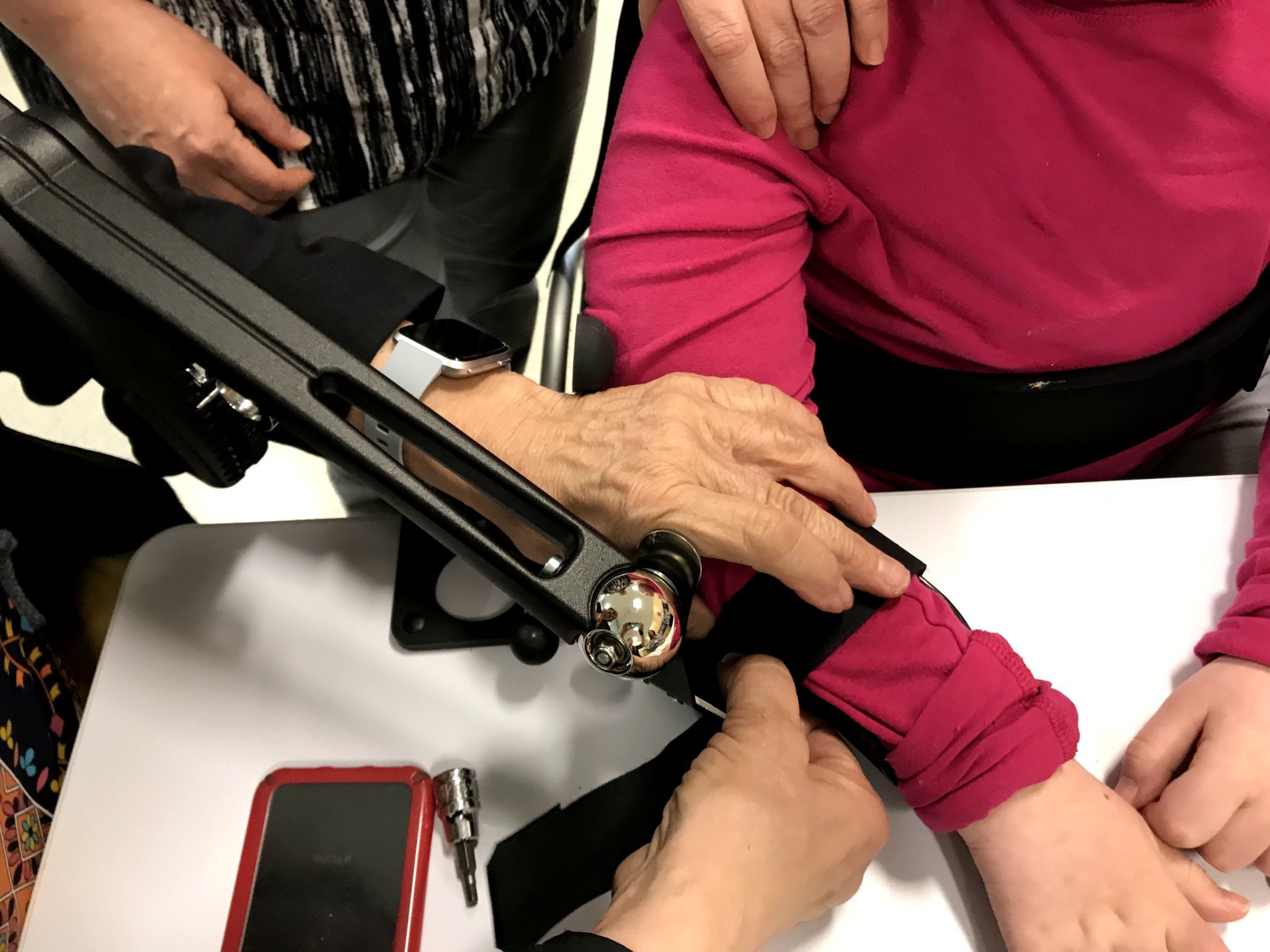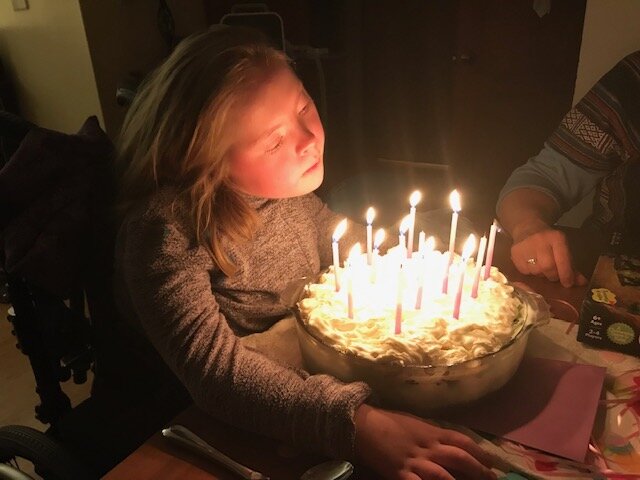I thought he was dead.
“Is he dead, Mom?” Talia asked as we peered into the brightly-lit tank in the waiting room at Spaulding Pediatric Outpatient Center. Talia and I spend a few hours here every week, trying to hold onto every muscle and nerve fiber for as long as we possibly can. The fish tank is our first stop after we check in, but we had never noticed this little guy before—a tiny, transparent, silver fish, just over an inch or so, lying on the bottom, motionless. At other visits we had been distracted and dazzled by the other, bigger, colorful fish darting about the waters above him—their lithe bodies a flash of color and motion.
“Um, I don’t know—maybe he’s just sleeping,” I replied sheepishly. Hovering over a bed of gray-white pebbles, surrounded by a plastic forest of kelp, he was certainly the smallest fish in the tank. He looked so vulnerable out there by himself--his black, bug-eyes fixed and scared-looking on either side of his head.
When our beloved physical therapist, “PT Heather” arrived, moments later, I gave her my wide-eyed “something’s-wrong-in-there” look, while jerking my head, saying “you might need to get a net for the ‘sleeping fish’ on the bottom of the tank,” my fingers forming air quotes above Talia’s head.
“Oh, that guy…I think he’s just sleeping—that’s where he usually hangs out.” Heather reassured us as she led us back toward the treatment rooms.
Tal and I looked at each other with doubt, as we craned our heads, peering back anxiously at the tank, hoping for some sign of life before we left our little friend.
In the days that followed I couldn’t stop thinking about him—or her. My daily thoughts consume me with worry and dread and the emotional toll of caring for my sweet girl, as she faces an endless barrage of loss from a progressive neuromuscular disease. And yet this little fish somehow penetrated the frenetic space that is my brain, a distracted, sometimes joyless organ consumed with finding a way to save my daughter. With each passing day I try to shore up a wall against the ever-rising tide of nerve death and weakness, as I frantically search for other ways to treat her disease, while we wait and wait for a treatment that we have championed forward. The chinks in the wall grow bigger with each passing day, as I drink from a firehose of despair.
Why was I thinking about this fish? Would it be the last time we saw him? My life so full of “lasts”--the last time she walked. The last time she slept without a machine to help her breathe. The last time she lifted a spoonful of yogurt to her mouth. The last time she touched her face to brush away a tickly wisp of soft, blonde hair.
* * *
The following week we made a beeline for the tank, distractedly announcing our arrival at the front desk.
And there he was. Swimming, or hovering in that same spot, his body still.
But this time he began fluttering his fins and puckering his tiny mouth open and closed. And then, what happened next still leaves me wondering about unknown forces in the universe. In an instant, six larger fish, silver and flat and quick, surrounded our little guy on all sides and above. I thought he was a goner—that we were about to witness some sort of fish cannibalism, like something out of National Geographic. But then the fish began a sort of dance, or something that reminded me of the flying formation of geese as they fly, fervently southward each Fall. One of them would swim away from the group, take a few laps around, return, and send off another who darted off toward the coral and bubbles, then find his way back and tag another to do the same. All the while our little fish remained at the center, barely moving.
Was this little guy sick? Or injured? Was she conserving energy to create and lay future eggs to propel her DNA forward into her watery world? Did she need the protection of the other fish--who somehow knew this?
The next moment “PT Heather” came and whisked us away, once again, interrupting my sociological study of the fish tank. As we wheeled back, Talia chatting about the exercises and machines she was excited about that day, we passed several other therapists, each of them greeting Tal with an enthusiastic “hello” or a “low five”, extending their hand downward to meet hers at its newer resting place, motionless, on her lap.
* * *
When we first met Heather, in 2014, I was suspicious of her sweetness and soft-spoken nature. If you know Talia you know she can be strong-willed—“a girl who knows what she wants” I’ve heard many a therapist or teacher say (sometimes accompanied by an eye roll or smirk). And while I am fiercely proud of this aspect of Talia’s personality, I know it can be challenging. I worried that Tal would have Heather wrapped around her finger, that those precious minutes and hours spent in physical therapy would be wasted on so much coaxing and cajoling.
We had also just left our trusted PT of the previous three years, “PT Tom”. He was kind and gentle and patient and had established a wonderful bond with Tal. He had enticed her into taking her first real, independent steps—a stilted, cautious journey of four tentative footfalls not unlike that of a newborn calf. Tal adored his funny ways and games. But when we returned after a long post-surgical hiatus, having just graduated from a daunting chest-to-toes, bright-orange SPICA cast after six long months, to a body brace of equal proportions, PT Tom was overwhelmed. He was clearly nervous and uncertain about how to get her walking again.
I had practically run from his office, holding my girl and her brace, a river of salty tears streaming down my face. I felt abandoned and alone at a time when we so desperately needed someone to hold our hands and help us to get Talia back on her feet.
If Heather felt daunted by the prospects of rehabilitating my girl out of her contraption she didn’t show it. Her Mary Poppins-like approach--pulling out endless props, games, music, and role play from her repertoire--worked magic with Tal. Within just a few weeks she and Talia had a routine and a rapport. Talia even worked through her horrific sleep study experience with Heather by re-enacting it and giving Heather the role of “wake-up Fairy”, complete with a wand full of glitter and stardust to end the sleep study and bring Talia back into the world of the awake.
Heather discovered what motivated Talia to take another ten steps after she said she was tired, to reach up just five more times for iridescent, floating bubbles, or to just call it a day and have a dance party with Queen playing over an iphone, metallic pom-poms shaking to the beat, and five other therapists joining in on the fun.
Together we got Talia back on her feet. She was walking again. For a time there was progression—longer times on the treadmill, more steps taken down the long hallway, higher pegs reached on the wall above her head. And then Talia’s disease began to rage. Progress came to a screeching halt. Over time, the steps dwindled, the distance shortened. And at some point we finally had a diagnosis and realized that this loss of skills was our new normal. We would not be rehabilitating anymore. It was unlikely that we would see further progress.
I’m sure people have characterized my reaction to Talia’s diagnosis—the relentless quest for a cure, or sometimes the refusal to acknowledge that her increasing weakness demanded a new piece of equipment—as sheer denial. But Heather has stood patiently by, over the years, with every loss, every slide backward, holding my hand, and waiting for me to get there in my own time.
I have shown up to PT on more than one occasion noiselessly broken and tearful, behind Talia’s wheelchair, out of view of my empathetic girl. Heather is quick to whisk Talia away to some fun distraction, giving me the space to breathe and cry.
As time passes and abilities change, Heather has brought other therapists into Talia’s circle of care. “OT Jen” has become part of our weekly routine, as we try to fire still-present nerves and muscles in arms and hands and provide Talia as much independence as possible. “Pool therapy Jen” meets us each week, expertly and gently putting Tal in the director’s seat each session. And while the water provides a way to stand, jump and float, its added pressure on Talia’s diaphragm makes it even harder to breathe.
We don’t really measure success anymore by the number of steps or the length of time Talia can complete an activity. The goal now is to hang onto what is left for as long as possible, to not go backward. But I know this is impossible without treatment.
The dance parties continue, though they look a bit different—Queen has been replaced by Macklemore. A wheelchair is a substitute for what used to be supportive hands and arms. Talia has found a way to dance in her chair, swinging and bobbing her head in time to the beat. The cast of characters of therapists and students is ever-changing, as they slip on their dancing shoes to join us. Talia’s giant, joyful smile remains the same.
And while I sometimes feel so lost in this sea of despair, drowning in love and heartache for my dying child, I know that we are surrounded by so many helpers. So much kindness. An enormous network of support and love, enveloping us at Spaulding, at Talia’s school, within our community—in so many aspects of our lives. We are broken and made whole again each week—each day—as we live on the edge of so much grief and hope.





